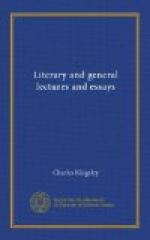And thus I end what little I have dared to say. There is much behind, even more worth saying, which must not be said. Perhaps some far wiser men than I will think that I have said too much already, and be inclined to answer me as Elisha of old answered the over-meddling sons of the prophets:
“Knowest thou that the Lord will take away thy master from thy head to-day?”
“Yea, I know it: hold ye your peace.”
Footnotes:
{0} The edition of “Literary and General Essays” that this transcription was taken from also contained “Phaethon; or, Loose Thoughts for Loose Thinkers” as the final part. This has been released separately by Project Gutenberg and is not, therefore, duplicated here.—DP.
{1} This Lecture was given at Harrow in 1873, and in America in 1874.
{35} Fraser’s Magazine, November, 1853.
{61} “Poems,” by Alexander Smith. London: Bogue. 1853. Fraser’s Magazine, October, 1853.
{103} Fraser’s Magazine, September, 1850.—“In Memoriam.” Moxon, Dover Street. 1850.—“The Princess, a Medley:” by Alfred Tennyson. Third Edition. 1850.—“Poems:” by Alfred Tennyson. 1852.
{127} North British Review, No. XXXI.—1.—“Elliott’s Poems.” London, 1833.—2. “Poems of Robert Nicoll.” Third Edition. Edinburgh, 1843.—3. “Life and Poems of John Bethune.” London, 1841.—4. “Memoirs of Alexander Bethune.” By W. M’Combie. Aberdeen, 1845.—5. “Rhymes and Recollections of a Handloom Weaver.” By William Thorn, of Inverury. Second Edition, London, 1845.—6. “The Purgatory of Suicides.” By Thomas Cooper. London, 1845.—7. “The Book of Scottish Song.” By Alexander Whitelaw. Edinburgh, 1848.
{187} Fraser’s Magazine, March, 1849.—“Sacred and Legendary Art.” By Mrs. Jameson. 2 vols. London. 1848, Longman and Co.
{199} Since this was written, Mrs. Jameson’s volume on the Legends of the Madonna has succeeded excellently in giving us, if not a complete, yet still a readable and modest picture of medieval Mariolatry.
{210} We are sorry to see, however, that Mrs. Jameson has been so far untrue to her own faculty as to join in the common mistake of naming Raphael’s well-known cartoon at Hampton Court, “Elymas the Sorcerer struck Blind.” On the supposition that this is its subject, its method of arrangement is quite unworthy of the rest, as the action would be split into the opposite corners of the picture, and the post of honour in the centre occupied by a figure of secondary importance; besides, the picture would lose its significance as one of this great series on “Religious Conviction and Conversion.” But, strange to say, Raphael has all the while especially guarded against this very error, by labelling the picture with a description of its subject. Directly under the central figure is written, “Sergius Paulus, Proconsul, embraces the Christian faith at the preaching of Paul.” Taking which simple hint, and looking at the face of the proconsul (himself a miracle of psychology) as the centre to which all is to be referred, the whole composition, down to the minutest details, arranges itself at once in that marvellous unity which is Raphael’s especial glory.




